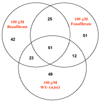Differential gene expression in mouse primary hepatocytes exposed to the peroxisome proliferator-activated receptor alpha agonists
- PMID: 17118139
- PMCID: PMC1683558
- DOI: 10.1186/1471-2105-7-S2-S18
Differential gene expression in mouse primary hepatocytes exposed to the peroxisome proliferator-activated receptor alpha agonists
Abstract
Background: Fibrates are a unique hypolipidemic drugs that lower plasma triglyceride and cholesterol levels through their action as peroxisome proliferator-activated receptor alpha (PPARalpha) agonists. The activation of PPARalpha leads to a cascade of events that result in the pharmacological (hypolipidemic) and adverse (carcinogenic) effects in rodent liver.
Results: To understand the molecular mechanisms responsible for the pleiotropic effects of PPARalpha agonists, we treated mouse primary hepatocytes with three PPARalpha agonists (bezafibrate, fenofibrate, and WY-14,643) at multiple concentrations (0, 10, 30, and 100 microM) for 24 hours. When primary hepatocytes were exposed to these agents, transactivation of PPARalpha was elevated as measured by luciferase assay. Global gene expression profiles in response to PPARalpha agonists were obtained by microarray analysis. Among differentially expressed genes (DEGs), there were 4, 8, and 21 genes commonly regulated by bezafibrate, fenofibrate, and WY-14,643 treatments across 3 doses, respectively, in a dose-dependent manner. Treatments with 100 muM of bezafibrate, fenofibrate, and WY-14,643 resulted in 151, 149, and 145 genes altered, respectively. Among them, 121 genes were commonly regulated by at least two drugs. Many genes are involved in fatty acid metabolism including oxidative reaction. Some of the gene changes were associated with production of reactive oxygen species, cell proliferation of peroxisomes, and hepatic disorders. In addition, 11 genes related to the development of liver cancer were observed.
Conclusion: Our results suggest that treatment of PPARalpha agonists results in the production of oxidative stress and increased peroxisome proliferation, thus providing a better understanding of mechanisms underlying PPARalpha agonist-induced hepatic disorders and hepatocarcinomas.
Figures





Similar articles
-
Plasma mannose-binding lectin is stimulated by PPARα in humans.Am J Physiol Endocrinol Metab. 2012 Mar 1;302(5):E595-602. doi: 10.1152/ajpendo.00299.2011. Epub 2012 Jan 3. Am J Physiol Endocrinol Metab. 2012. PMID: 22215653 Clinical Trial.
-
Microarray analysis of gene expression changes in mouse liver induced by peroxisome proliferator- activated receptor alpha agonists.Biochem Biophys Res Commun. 2002 Jan 25;290(3):1114-22. doi: 10.1006/bbrc.2001.6319. Biochem Biophys Res Commun. 2002. PMID: 11798191
-
Comparative gene expression profiles induced by PPARγ and PPARα/γ agonists in rat hepatocytes.Toxicol Appl Pharmacol. 2011 Jul 1;254(1):18-31. doi: 10.1016/j.taap.2011.04.005. Epub 2011 Apr 14. Toxicol Appl Pharmacol. 2011. PMID: 21515302
-
Peroxisome proliferator-activated receptor-α activation and excess energy burning in hepatocarcinogenesis.Biochimie. 2014 Mar;98:63-74. doi: 10.1016/j.biochi.2013.11.011. Epub 2013 Nov 28. Biochimie. 2014. PMID: 24291192 Review.
-
Peroxisome proliferator-activated receptor-alpha and liver cancer: where do we stand?J Mol Med (Berl). 2005 Oct;83(10):774-85. doi: 10.1007/s00109-005-0678-9. Epub 2005 Jun 23. J Mol Med (Berl). 2005. PMID: 15976920 Review.
Cited by
-
Transcriptomic signatures of peroxisome proliferator-activated receptor α (PPARα) in different mouse liver models identify novel aspects of its biology.BMC Genomics. 2014 Dec 15;15(1):1106. doi: 10.1186/1471-2164-15-1106. BMC Genomics. 2014. PMID: 25511156 Free PMC article.
-
Different Coactivator Recruitment to Human PPARα/δ/γ Ligand-Binding Domains by Eight PPAR Agonists to Treat Nonalcoholic Fatty Liver Disease.Biomedicines. 2024 Mar 11;12(3):624. doi: 10.3390/biomedicines12030624. Biomedicines. 2024. PMID: 38540237 Free PMC article.
-
Carbon tetrachloride affects inflammation-related biochemical networks in the mouse liver as identified by a customized cDNA microarray system.Environ Health Prev Med. 2010 Mar;15(2):105-14. doi: 10.1007/s12199-009-0117-6. Epub 2009 Nov 13. Environ Health Prev Med. 2010. PMID: 19911120 Free PMC article.
-
Genetic Basis of Irritant Susceptibility in Health Care Workers.J Occup Environ Med. 2016 Aug;58(8):753-9. doi: 10.1097/JOM.0000000000000784. J Occup Environ Med. 2016. PMID: 27206134 Free PMC article.
-
Gene Expression Changes Induced by PPAR Gamma Agonists in Animal and Human Liver.PPAR Res. 2010;2010:325183. doi: 10.1155/2010/325183. Epub 2010 Oct 19. PPAR Res. 2010. PMID: 20981297 Free PMC article.
References
-
- Schoonjans K, Staels B, Auwerx J. Role of the peroxisome proliferator-activated receptor (PPAR) in mediating the effects of fibrates and fatty acids on gene expression. J Lipid Res. 1996;37:907–925. - PubMed
-
- Schoonjans K, Staels B, Auwerx J. The peroxisome proliferator activated receptors (PPARS) and their effects on lipid metabolism and adipocyte differentiation. Biochim Biophys Acta. 1996;1302:93–109. - PubMed
MeSH terms
Substances
LinkOut - more resources
Full Text Sources

